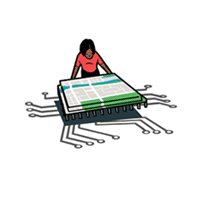Part of the Disruptors Series
April 1, 2021
Whether it is a new vaccine, the next must-have smartphone app, or even a plant-based burger, scientists and developers take advantage of the ability to refine a product in the lab before testing it in the real world and, ultimately, selling it to the customer. In IT, developers work in virtual testing environments called sandboxes to experiment and evaluate software programs and identify potential issues, like threats to cybersecurity, before they arise.
In fact, when most industries set out to develop a new product or solve a problem, they rely on using laboratories, testbeds, or other workspaces to refine and optimize their ideas. But that kind of experimentation and testing is simply not a part of standard planning processes. Could planners use a sandbox in our toolbox? Might smart city digital twins (SCDT) be the answer?
The conversation about experimentation in the planning world can get a little complicated. Sticking to the familiar way of doing things is often the path of least resistance as we balance the needs of residents, stakeholders, and local officials. Yet many plans and policies would benefit from undergoing a test stage before implementation. Up until now the options to do so have been fairly limited.
The concept of using predictive technology in planning is not new. Planners already run traffic simulations to understand transportation demand or factor in energy use patterns to predict future greenhouse gas emissions. But these are often disjointed attempts that don't account for the fact that cities are complex, meaning policy decisions in one area might end up impacting the built environment of another area. Planners need a more integrated way of simulating the complex potential futures of their cities.
Especially since the dawn of the smart city era, planners have been using our own communities as labs, piloting projects and programs on select city streets or in certain districts. But those urban labs aren't actually laboratories — a controlled space for experimenting — at all. They are often actual neighborhoods where real people live, work, play, and are vulnerable. When planners experiment in these labs, there are real-world consequences.
Prototyping ideas, then learning and adjusting can greatly improve outcomes. A recent edition of PAS QuickNotes on design thinking illustrates this idea in the planning field. When done thoughtfully, it can expand public engagement, facilitate community acceptance, and reduce financial risks. Yet as planners, we haven't had a space where we can holistically experiment within the context of an integrated urban system without having to face real-world consequences.
Smart city digital twins promise to change that. SCDT allow planners to explore new solutions to urban problems, improve planning activities such as public engagement and zoning, and address complex issues like climate resilience — all in a controlled environment that mimics the real city — while also offering a viable tool for telling a city's stories and communicating plans, policies, and outcomes.
What is a city digital twin?
The term "digital twin" has existed since the early 2000s. Beginning with applications in manufacturing and construction, various industries have since come to define the term in their own contexts. According to IBM, a digital twin "is a virtual representation of a physical object or system across its lifecycle, using real-time data to enable understanding, learning and reasoning." Siemens adds to that the ability of a digital twin "to simulate, predict, and optimize the product and production system before investing in physical prototypes and assets."
In the planning context, we are mainly talking about digital twins of entire cities. According to Arup, "the promise of the city digital twin is to help provide a simulation environment, to test policy options, bring out dependencies and allow for collaboration across policy areas, whilst improving engagement with citizens and communities."
Advancements in technology for smart cities — such as the deployment of information communication technology, sensors, and the Internet of Things — enable us to collect data about pretty much every movement, flow, or activity in a city. The availability of this data, combined with increased computing power and artificial intelligence, can allow for the digitalization of entire cities.
The synergy of these technologies essentially leads to the development of smart city digital twins (see the PAS Quicknotes on SCDTs). SCDTs can improve decision-making processes and allow for simulation and experimentation with real-time data.
Digital twin technology is relatively new to planners, as are smart city applications. But this shift signals the end of our days of limited experimentation. Planners have the chance to go beyond simulations that can only focus on isolated questions due to limited capabilities. While not quite mainstream yet, according to ABI Research, by 2025 more than 500 city digital twins will be deployed globally. So planners can expect digital replicas of entire cities and their systems sooner rather than later — that is, if they're ready to take the first steps.
Why city digital twins matter
In general, planners need to take advantage of tools that can make their work more agile. (This idea is gaining traction; read more about it in a February blog post: bit.ly/3quRV7n.) In the case of city digital twins, being able to quickly test ideas and make necessary adjustments before finalizing planning and policy decisions can allow planners to keep up with the accelerated pace of change that characterizes our world.
City digital twins can improve planning activities such as public engagement, scenario planning, and zoning and development. They have the potential to assist planners in reaching local climate resilience, economic development, and housing goals (just to name a few).
Another added benefit is the ability of city digital twin platforms to foster collaboration between planning organizations and other city departments and agencies.
The city digital twin can serve as the site where all city data lives: environmental indicators, resource consumption, zoning regulations, total housing units, transportation patterns. Undertaking a city digital twin project can prompt cities to standardize data from multiple areas in a single repository and share it across their various initiatives and programs, promoting cross-departmental experimentation that better understands interdependencies between policies and infrastructure systems.
Scenario planning has always allowed planners to make sense of uncertain futures. Digitally exploring potential impacts through city digital twins can minimize uncertainty. While planners strive to consider all aspects before moving forward, we know it's common for some things to slip through the cracks due to lack of time or budget. Using a city digital twin can reduce risks by giving planners the opportunity to notice something before it's too late.
And being able to holistically assess the viability of ideas can encourage planners to think outside the box. Decision makers may often reject projects or policy ideas because they are unfamiliar terrain or because they're just too risky to even consider. City digital twins can remove the need to devote valuable time and resources to experimenting with ideas that end up being impractical or poorly received. This low-risk, low-cost experimentation leads to time and money saved in the long term.
Data fairness and equity
Digital twins are simulating everything that is happening in the real-world smart city. Almost. As with any digital tool, planners have to be mindful of unintentionally reproducing inequalities from the analog world in the digital world.
No matter how "big" data might be, it isn't perfect. The three Vs of big data traditionally include volume, velocity, and variety. Planning for fair and equitable outcomes requires planners to add value and validity to the mix.
Data that feeds into city digital twins primarily comes from smart city applications, online devices, and sensors. That means anything or anyone not connected to (or recognized by) these technologies will likely be missing from the dataset. And these gaps in the data can hinder the success of a project. Even worse, data gaps can also be severely and disproportionately harmful to those who are left out. It is imperative to know where data comes from, how it was collected, and who and what it might exclude.

The deployment of AI systems is growing, but the decision-making capabilities of algorithms and AI programs can reinforce discriminatory planning practices.
Planners should use city digital twins to embrace the diversity that lives within a city, and this starts with having equity in mind from the beginning. As we already know, different population groups will have different needs. Recognizing the inaccuracy and incompleteness of the datasets is crucial.
For instance, mobility data collected from location services typically only includes people who move through the city carrying smart devices, like smartphones. This approach often excludes children, the elderly, and unbanked people, leaving cities with an incomplete picture of the community. Cities need to work to fill data gaps through inclusionary approaches, like sharing data findings with residents to verify it and working directly with on-the-ground community groups to gather additional data.
"You have to overcome data gaps by really listening to people and questioning whether your source of data is representative of their lives and experience," says Nayeli Rodriguez, Technologist for the Public Realm at the Mayor's Office of New Urban Mechanics in Boston.
To ensure smarter, more complete base data that supports a smart city digital twin, cities need high-quality data governance. Boston has shown its commitment to responsible data use and governance, adopting an initial set of data trust principles that communicate that data isn't just for governments and institutions. The city wants to equip city staff and residents with the tools and knowledge to use data effectively.
"We want to draw residents' attention more and more to these systems that collect data," she says. "Not only because it helps them to safeguard their own privacy and data, but it will also guide us as planners to make better decisions that are more representative of what residents want out of the city."
As more and more cities start to develop their own digital twins, the tool could extend far beyond its current uses. Cities facing threats from coastal and riverine flooding might be looking for a way to simulate future flooding events, comprehensively manage risks, and rapidly create recovery plans. And many cities are still figuring out how to meet public engagement requirements during a pandemic or other public health crises. Digital twins can help stakeholders visualize projects and developments, even in remote situations.
Others could employ smart city digital twins as a visualization tool, illustrating policies and plans to decision makers and the public, or as a way to gather feedback to support the cocreation of plans.
Regardless of how they are used, the central purpose of city digital twins is helping planners to create great communities for all. From climate adaptation and resilience planning to creative public engagement, city digital twins are flexible, agile, and promising tools to streamline planning processes and increase productivity in planning organizations.









